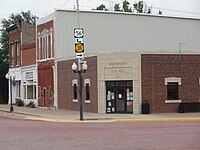
Photo from wikipedia
This study identified spatial clusters of type 2 diabetes mellitus among participants of the Brazilian Longitudinal Study of Adult Health (ELSA-Brasil) residing in two cities and verified individual and neighborhood… Click to show full abstract
This study identified spatial clusters of type 2 diabetes mellitus among participants of the Brazilian Longitudinal Study of Adult Health (ELSA-Brasil) residing in two cities and verified individual and neighborhood socioeconomic environmental characteristics associated with the spatial clusters. A cross-sectional study was conducted with 4,335 participants. Type 2 diabetes mellitus was defined as fasting blood glucose ≥ 126mg/dL (7.0mmol/L), oral glucose tolerance test ≥ 200mg/dL (11.1mmol/L), or glycated hemoglobin ≥ 6.5% (48mmol/L); by antidiabetic drug use; or by the self-reported medical diagnosis of type 2 diabetes mellitus. Neighborhood socioeconomic characteristics were obtained from the 2011 Brazilian census. A spatial data analysis was conducted with the SaTScan method to detect spatial clusters. Logistic regression models were fitted to estimate the magnitude of associations. In total, 336 and 343 participants had type 2 diabetes mellitus in Belo Horizonte, Minas Gerais State (13.5%) and Salvador, Bahia State (18.5%), respectively. Two cluster areas showing a high chance of type 2 diabetes mellitus were identified in Belo Horizonte and Salvador. In both cities, participants living in the high type 2 diabetes mellitus cluster area were more likely to be mixed-race or black and have a low schooling level and manual work; these were also considered low-income areas. On the other hand, participants in the low type 2 diabetes mellitus cluster area of Salvador were less likely to be black and have low schooling level (university degree) and live in a low-income area. More vulnerable individual and neighborhood socioeconomic characteristics were associated with living in clusters of higher type 2 diabetes mellitus occurrence , whereas better contextual profiles were associated with clusters of lower prevalence.
Journal Title: Cadernos de saude publica
Year Published: 2023
Link to full text (if available)
Share on Social Media: Sign Up to like & get
recommendations!